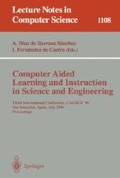Abstract
This paper presents a model of Computer Integrated Learning Environments (CILE) as adopted by TLTP Byzantium and the role of an Intelligent Tutoring Tool (ITT) within this model. It reviews the implementation of artificial intelligence, discussing the methodology used in storing the knowledge rules and their application by the inference engine. An ITT is a fine grain tutoring tool that provides for learning as well as assessing the conceptual knowledge with the help of a student model, a remote expert model and a local expert model. The dominant consideration in the design of an ITT is to keep the feedback short and simple and to drop to a finer grain size, through a suitable interface, wherever necessary. Other aspects of the ITT design are also discussed and some of the main features and weaknesses are identified.
Preview
Unable to display preview. Download preview PDF.
References
Anderson J. R. (1988). The expert module. Foundations of Intelligent Tutoring Systems (Eds. M. C. Poison & J. J. Richardson), Lawrence Erlbaum, Hillsdale, NJ, pp21–53.
Dalal N. P. & Kasper G. M. (1994). The design of joint cognitive systems: the effect of cognitive coupling on performance. International Journal of Human-Computer Studies, 40, pp677–702.
Kinshuk (1995). The influence of interface design upon the effectiveness of computer aided learning programs in entry level subjects. MPhil-PhD transfer document, De Montfort University, UK, January 1995.
Kruglinski D. J. (1993). Object Linking and Embedding (OLE), Inside Visual C++, Microsoft Press, Redmond, USA,pp 473–479.
Patel A. (1995). Intelligent Tutoring Tools: An evaluation of TLTP Byzantium's approach to software design for a computer integrated learning environment, Project report, De Montfort University, UK, September 1995.
Routen T. (1992). Reusing formalisations of legislation in a tutoring system. Artificial Intelligence Review, 6, pp145–159.
Self J. (1988). Student models: what use are they? Artificial Intelligence Tools in Education (Eds. P. Ercoli & R. Lewis). North Holland, Amsterdam, pp73–86.
Wayner P. & Joch A. (1995). Agents of Change — beyond the hype, software is getting smarter at helping us solve real problems. BYTE, March 1995, pp95.
Author information
Authors and Affiliations
Editor information
Rights and permissions
Copyright information
© 1996 Springer-Verlag Berlin Heidelberg
About this paper
Cite this paper
Patel, A., Kinshuk (1996). Applied artificial intelligence for teaching numeric topics in engineering disciplines. In: Díaz de Ilarraza Sánchez, A., Fernández de Castro, I. (eds) Computer Aided Learning and Instruction in Science and Engineering. CALISCE 1996. Lecture Notes in Computer Science, vol 1108. Springer, Berlin, Heidelberg. https://doi.org/10.1007/BFb0022600
Download citation
DOI: https://doi.org/10.1007/BFb0022600
Published:
Publisher Name: Springer, Berlin, Heidelberg
Print ISBN: 978-3-540-61491-3
Online ISBN: 978-3-540-68675-0
eBook Packages: Springer Book Archive

